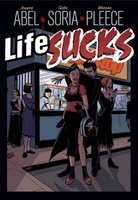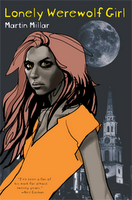
Personally, I believe there's an under-the-radar sort of genre involving books about early-twenty-something characters who are coming to terms with the fact that life, well, sucks. That pretty much describes, in a nutshell, the graphic novel Life Sucks by Jessica Abel, Gabe Soria, and Warren Pleece.
The basic set-up for this book is just brilliant. Two years before the start of our story, our hero, Dave Miller, applied for a night job at a convenience store so he could attend community college during the day. The store owner, Radu, (who prefers to be called Lord Arisztidescu) is an immigrant (from some eastern European country, I'd guess)who turns Dave into a vampire. Now Dave must be Radu's...er, Lord Arisztidescu's...low-wage slave--through eternity! As if that isn't bad enough, Dave can't tolerate the idea of blood so he can't go around preying on humans. This means he'll never become a strapping, healthy vampire, just a miserable, little weak one with a job working permanent nights. Really permanent.
Yes! Life does, indeed, suck!
While not necessarily roll-on-the-floor funny, Life Sucks definitely is drole and clever, particularly if, like me, you enjoy dark, subtle humor. There's lots of humorous takes on traditional vampire lore. And, I guess, traditional convenience store lore.
I can't say I loved the art, but it is dark and moody to fit the subject matter, and it carries the narrative very well. I read a rather lame graphic novel a couple of weeks ago that had to use a lot of what I think you might call narrative boxes because the graphics weren't telling the story by themselves. Nothing like that here. The art carries everything but the dialogue.
This book would be a big draw for your older, edgier YAs who are already beginning to suspect that life sucks. While I was reading it, I was wondering who I knew who might like it for Christmas.
Life Sucks is one of this year's graphic novel Cybils nominees.
Viewing: Blog Posts Tagged with: di bates, Most Recent at Top [Help]
Results 1 - 4 of 4
Blog: Original Content (Login to Add to MyJacketFlap)
JacketFlap tags: YA, graphic novels, Cybils nominees, Older teens, Add a tag
Blog: Original Content (Login to Add to MyJacketFlap)
JacketFlap tags: Reader response, Older teens, Zenny books, Add a tag

In Martin Millar's Lonely Werewolf Girl, Verasa, Mistress of the Werewolves, is concerned about bringing her Scottish werewolf clan into the modern world. Werewolves in Millar's urban fantasy live a long time--a long time. They keep their youthful good looks and vigor for many decades but some of them seem somewhat stodgy and middle-aged. They can't even bring themselves to talk about the young orphaned twin werewolves who are intent on becoming successful punk rockers in London when they're not in drunken stupors, which is pretty much all the time. (Much like the fairies in Millar's Good Fairies of New York.) And when the twins show up at the family castle, all the moms and dads are quick to tell their puppy offspring that, no, they cannot dye their hair pink or blue the way their depraved cousins have.
The MacRinnalch's are sort of like any large, well-to-do, conservative family in one of those stories (or TV series) about family intrigue. You've got brother fighting brother for control of the family. You've got an ambitious fashion designer who wants nothing but to forget her relatives and concentrate on her work. You've got an icy academic. You've got backstabbers and hangers-on. You've got a cross-dresser.
They're just all werewolves.
As I always tell the kiddies when I do a school presentation, I find bringing unlike elements together funny. I like this kind of thing. A lot.
Like Good Fairies, Lonely Werewolf Girl is one of those Zenny kinds of books that require the reader to get into the moment. It's made of a whole series of short vignettes about its large cast of characters. It doesn't take long to get to know them and start feeling excited because the story has moved back to the Fire Queen (a former warrior queen from another dimension who now fights all her battles over haute couture) or Dominil, who might be described as a bored werewolf bitch (as in bitchie, not female, though she is). However, a stronger narrative drive kicks in about halfway through when the conservative and violent Sarapen becomes really serious about killing off many of his relatives in his bid to become head of the clan.
I have to say that the book seemed to begin with an odd "telling" type style in places, but either Millar gave it up or I liked what I was being told so much that I no longer noticed it.
Since this is a kidlit blog, I must raise the question of whether or not Lonely Werewolf Girl, published as an adult book, can work as a crossover work for YAs. I think so, particularly for older YAs who will have more interest in adult skullduggery, given that they're closer to it.
Plus there is the Lonely Werewolf Girl, herself, Kalix. At seventeen, she is far younger than her siblings--a sort of menopause baby in werewolf terms--and suffers from depression, anxiety, and what sure looks like anorexia to me. In her early teens she fell in love with the brooding and poetic Gawain, a werewolf not up to her family's standards. After her father, the leader of their clan, banishes Gawain to get him out of his daughter's life, Kalix physically attacks him. Since she could be said to "suffer" from a sort of madness when in battle, she gets the best of that encounter, and injures the old man so badly that he later dies. She heads out for London, and other members of the family want to hunt her down and bring her home for punishment, which may or may not mean death.
You know how a common YA theme is separating self from family? Well, there you go. Kalix is separated and suffering, living on the street, filthy, lovelorn, and drugged up on laudanum.
This young teen character initiates the action--because she killed her father, his position as head of the clan is up for grabs and leads to a war between her two older brothers. Kalix's grandmother wants her dead, and the brother who will kill her will get grandma's support for his bid for leadership. In fact, a lot of people and werewolves want Kalix dead, and as a result, though the action moves to other characters, it keeps coming back to her and the teenage human university students who are helping her. Help, by the way, includes exposing her to cable TV and Sabrina, the Teenage Witch.
Both in terms of characters and pop culture, there's plenty here to hold a younger person's attention. But Millar has been described as a counter culture novelist. I think that aspect of Lonely Werewolf Girl will also be attractive to teen readers who are desperate to read something off an official school reading list.
Lonely Werewolf Girl was inspired, in part, by the end of Buffy the Vampire Slayer , in that Millar has said "I felt such a dreadful loss, I thought I'd have to write my own." I can see the influence in that, as I got toward the end of this quite long book, I felt I was going to miss spending time with many of these characters.
Blog: Scribblings (Login to Add to MyJacketFlap)
JacketFlap tags: poetry, blog tour, claire saxby, di bates, assemble, little ears, ready ed, meredith costain, Add a tag
The mail man brought me something nice today – my contributor copy of Little Ears magazine, bearing my poem Raining. Always wonderful to see something I’ve written in print, and especially wonderful to see it included in such a quality publication, alongside names including Claire Saxby, Meredith Costain and Dianne Bates. By email I also received something nice – a PDF of proofs for my new
Blog: PaperTigers (Login to Add to MyJacketFlap)
JacketFlap tags: Children's Books, Young Adult Books, Authors, Butterflies, Susanne Gervay, That-s Why I Wrote This Song, I Am Jack, Big Bad Bruce, Buzz Words, Di Bates, The Hold-Up Heroes, Tory Gervay, Add a tag
The 1970’s marked the coming of age for Australian children’s literature, says YA writer Susanne Gervay. “There was a new breed of children’s authors and illustrators reflecting a confidence in an Australian identity and its landscape in all its diversity.” Contributing to the subsequent explosion of “best selling wickedly irreverent kids’ books” was the writers’ use of quirky Australian humor.
Among the writers of those “innovative, brazenly Australian” early books for children, Gervay cites Di Bates, a prolific writer who is still a bundle of energy. Bates produces a fortnightly online newsletter, Buzz Words, with industry news for writers, editors, illustrators and librarians. Subscribers also receive Books Buzz, a monthly compendium of reviews of new books by Australian children’s writers. Alliteration-loving Bates’ latest books are Big Bad Bruce and The Hold-Up Heroes.
Gervay’s own recent innovations in children’s literature are cross-media and inter-generational collaborations. After publishing frank and open YA books treating disability (Butterflies) and bullying (I Am Jack), her most recent book, That’s Why I Wrote This Song, was inspired by her rock musician daughter Tory’s lyrics and tune. Tory and Susanne now do speaking gigs together, and Susanne’s website features links to MySpace and YouTube. Her expertise on Cutting Edge YA Literature was featured in the July PaperTigers update. And here’s Aline’s recent blog post, with more details on Gervay’s cross-media innovations.



I liked this one so much -- Clerks with vampires!